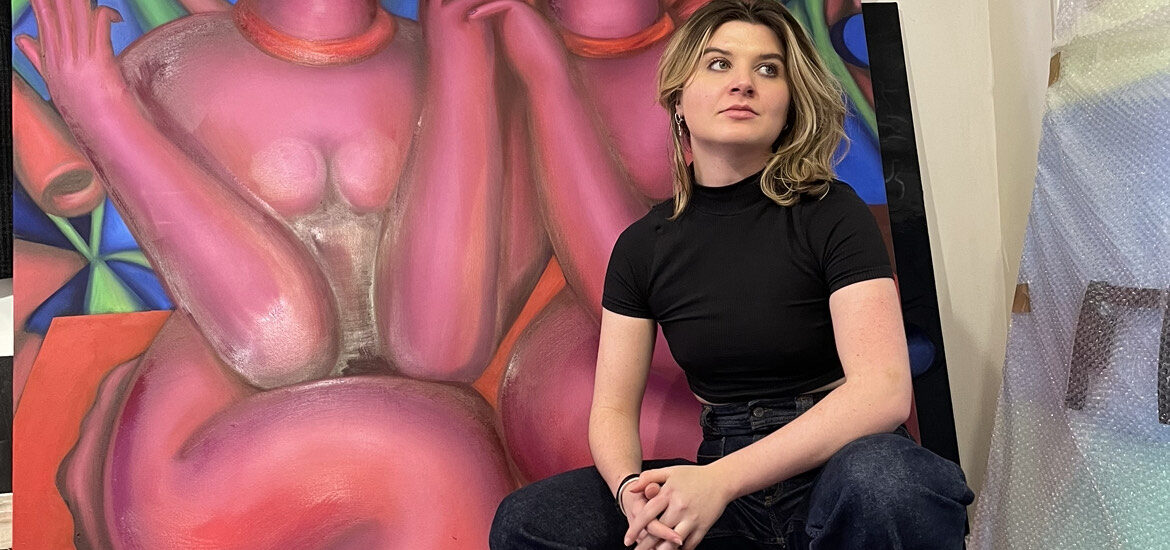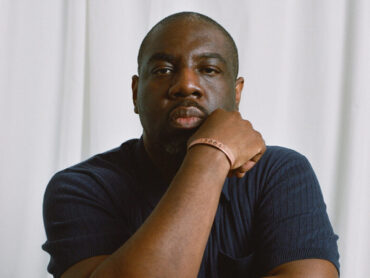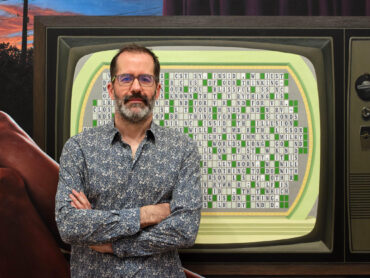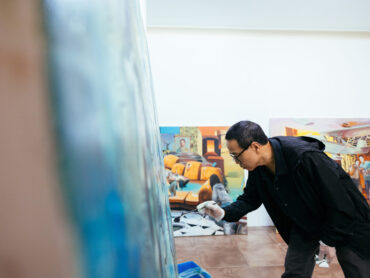In the countryside of Derbyshire, England, Georgia Dymock grew up in her family home, with her brother and her parents. It was, and still is, a creative place full of odd objects and antique finds with bits and bobs that interested her parents. There was plenty to be inspired by. For her, today, home is always a soothing place to return to, and she gets pumped full of creative energy when she is there. In this unique space, she was raised without the Internet, which is quite an accomplishment for her parents in this epoch. I’ve been contemplating this since speaking to her about how disentangling that could be.
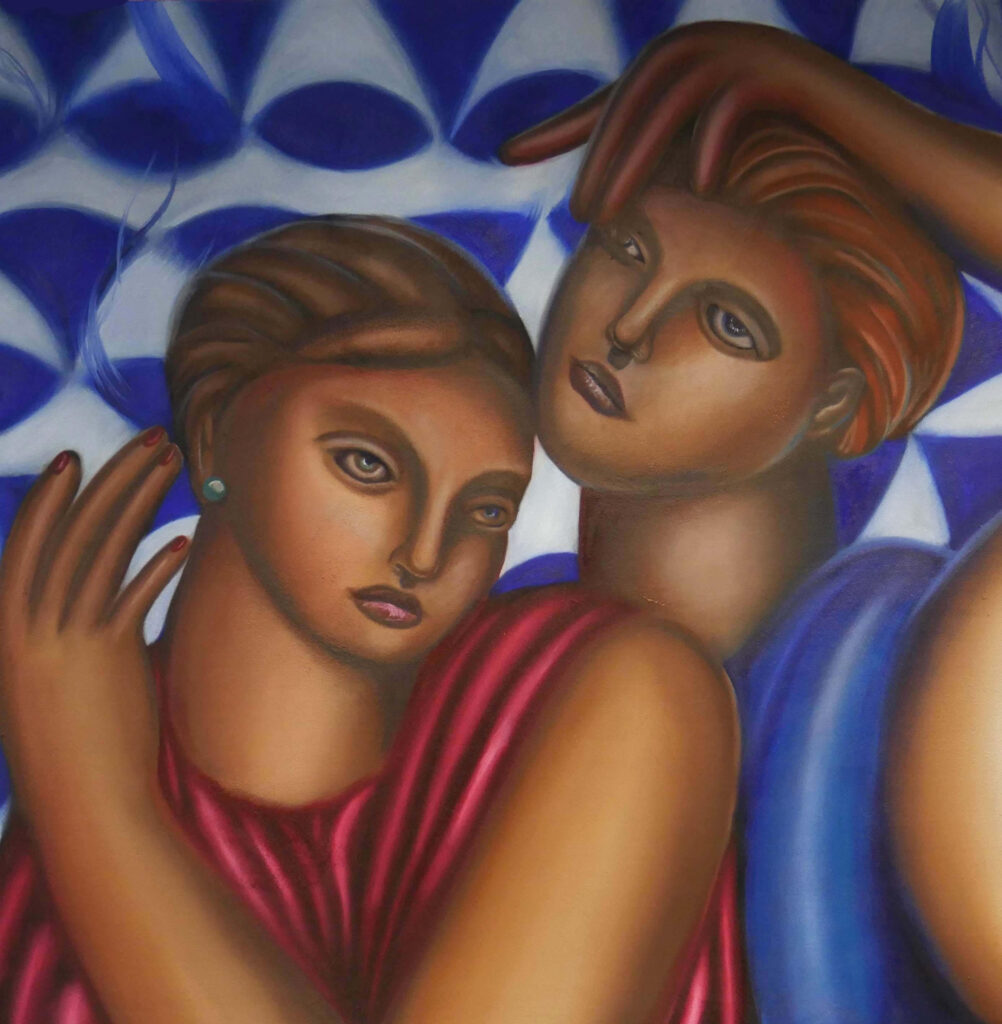
“Two Figures Looking Out” 2023 Photo courtesy of: JD Malat Gallery
As William Irwin Thompson once wrote, “We are like flies crawling across the ceiling of the Sistine Chapel: We cannot see what angels and gods lie underneath the threshold of our perceptions. We do not live in reality; we live in our paradigms, our habituated perceptions, our illusions: the illusions we share through culture we call reality, but the true historical reality of our condition is invisible to us.” She was not an active participant online in her paradigm. With that mindset, she developed her metier in a more undisturbed, hushed space.
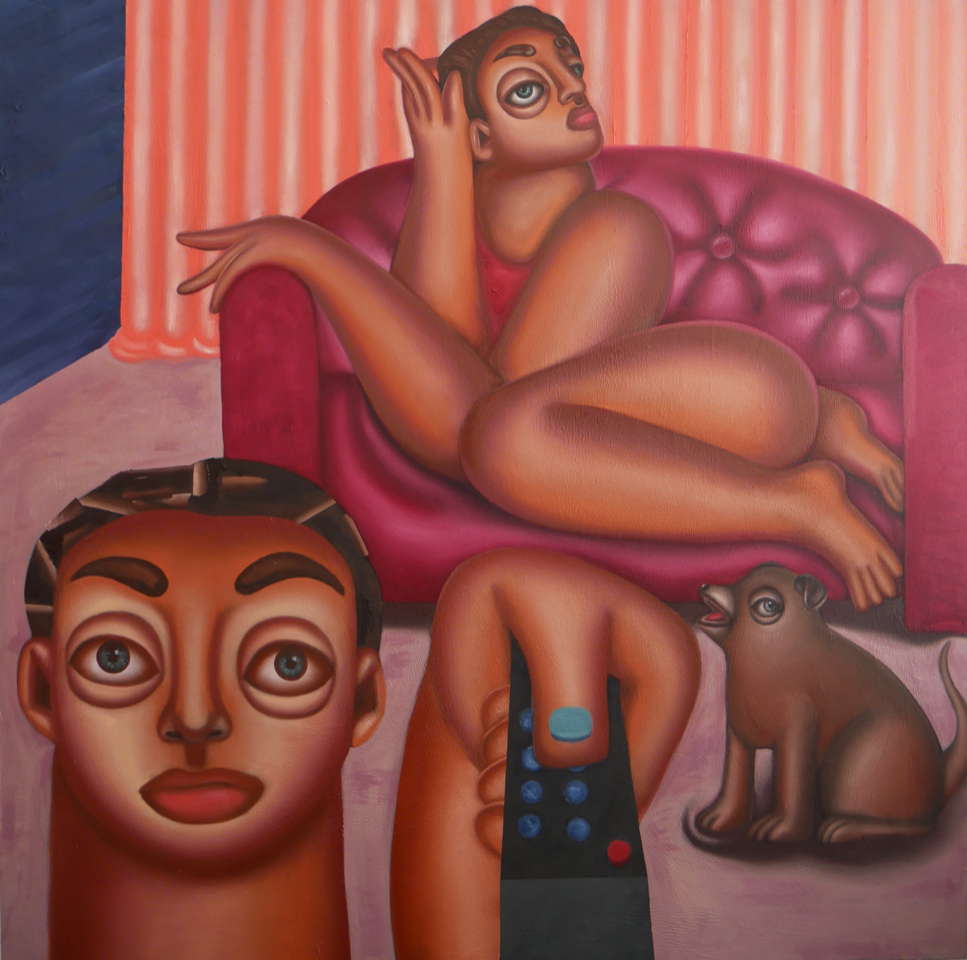
“Netflix and Chill” 2022 Photo courtesy of: JD Malat Gallery
As a youth, Georgia was envious of friends who played video games on electronic devices. But she also experienced her world without the influencers’ sway. She was with her brother, and they were outside, where their days were filled with their imaginations. Today, she reflects on how beautiful it was because she had time to develop at another pace: to be present and create spaces that were uniquely hers. These spaces are at the forefront of the art she now makes.
She mixes sand in her oil paints in a sea of figurative art bearing prominently limbed figures, questioning what it means to be a human now, disembodied. To be truly aware of the physical limitations. Contorting the bodies was a significant exploration on her part. She devoted alternative shades of color to the beautiful faces and blues in the bodies rather than only applying flesh tones. Compelling her mood on the canvas with paint.
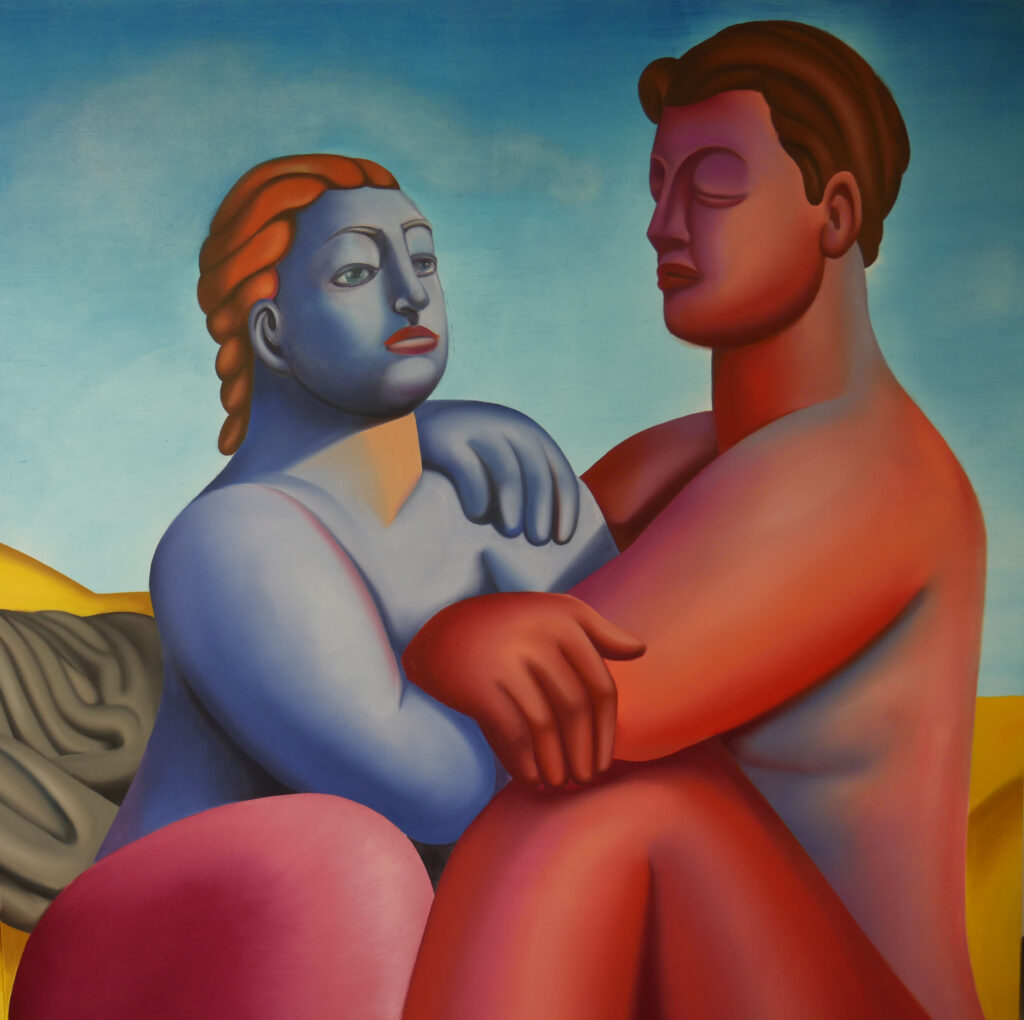
“Figures Holding Each Other” 2023 Photo courtesy of: JD Malat Gallery
It makes her paintings stand out, as her inventiveness was not generated in small, short snippets trending on TikTok but more of a long fairy tale presence in her mind.
Her artworks are a sentiment or reflection on how she feels that day; her characters are formed from her feelings, not a particular person. The hues have a high saturation, materially making a body like a mood ring. Peaceful, calm, and focused. Her attitude welcomes the good in, and she is grateful to push herself, acknowledging that the opportunity to do a lot of work is a privilege.
Ironically, for someone who grew up without the Internet, Instagram became a significant springboard once she utilized it. She received praising feedback when she posted her artwork and found it motivating for the next painting. However, the constant calling of dopamine from likes on social media made her feel distracted and unsatisfied, and she realized she was a little addicted to her phone. She desired to find a place to focus, so she began meditating and resisting the urge to get scattered. She says, “Now I can find I am painting for five hours at a time. I get sucked in. Time goes by very quickly, getting in the flow. I would spend hours and hours focused on one task.” Which now transfers to her work ethic. She tries to be as open as possible, free in her creativity, invoking a playfulness to dab into.
Before art, Georgia studied geography and then anthropology. After a while, she realized school wasn’t fulfilling her potential; something was missing, and she felt she should go on a creative journey. Within a year of studying art, she completed her degree in anthropology and got a studio. Having a studio allowed her to fall into herself. Being in an environment around other artists, which she had never had, also fueled her creativity.
In the beginning, she used to make abstract figures. Then, during COVID-19, she jumped into figurative back home, as she expressed she “wanted to try it, and felt safe.” It enabled her to decide to go to the Slade School of Art. During this time, she connected the past and present of technology and creative freedom. Painting multiple aspects of what it is to be human. These feelings connected her to her community “to feel alive in your body, to be aware of how your physical presence feels.One of the most important things for a person is having purpose and feeling ok in their own skin.” she says. It all links to her childhood freedom when painting was a hobby. When she is painting now, she states, “I am very aware I am a painter; I am aware of what I am saying.”
Within three years, she has works selling at Christie’s, solo exhibitions, and representation by the JD Malat Gallery, in London.
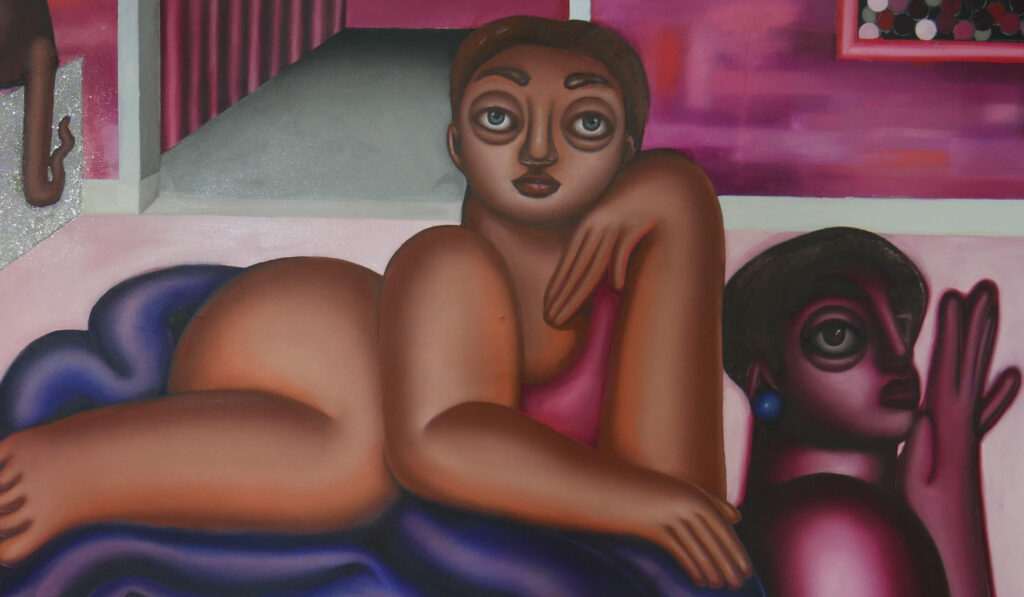
“Two Figures with Cat Tail” 2022 Photo Courtesy of: JD Malat Gallery
DP- Your figures have taken on more vibrant hues, from flesh color to fuchsia and blues. Has reimagining the tones conformed your work and given you more freedom with how you paint them?
GD- Using Vibrant colors helps me to reimagine the human form in playful ways. I’m interested in how color can inform meaning and alter the mood of a work. A blue figure can feel thoughtful and melancholic, whereas a figure rendered in red can come across as full of blood, angry, with life.
DP- Why do you mix sand with oil in your paintings?
GD- I add sand to paint to add texture, offering a rough surface that I work against to render forms with gentle gradients. The addition of sand to the surface causes a scattering of paint that resembles an airbrush; this is an effect I like as it achieves a digital/ mechanical aesthetic. In my most recent work, I use a smooth white surface. I enjoy what this different surface offers, where the lack of resistance means the paint can be applied in long sweeping strokes; I like how the white ground can optically combine with the translucency of oil paint.
DP- There is a sense of androgynous, gender-neutral identity in your work. The figures seem feminine but without an apparent gender. Is this something you explore?
GD- Often, I’m happy for the figures in my paintings to maintain a sense of ambiguity; they may lean into characteristics of femininity or masculinity without a hard definition.
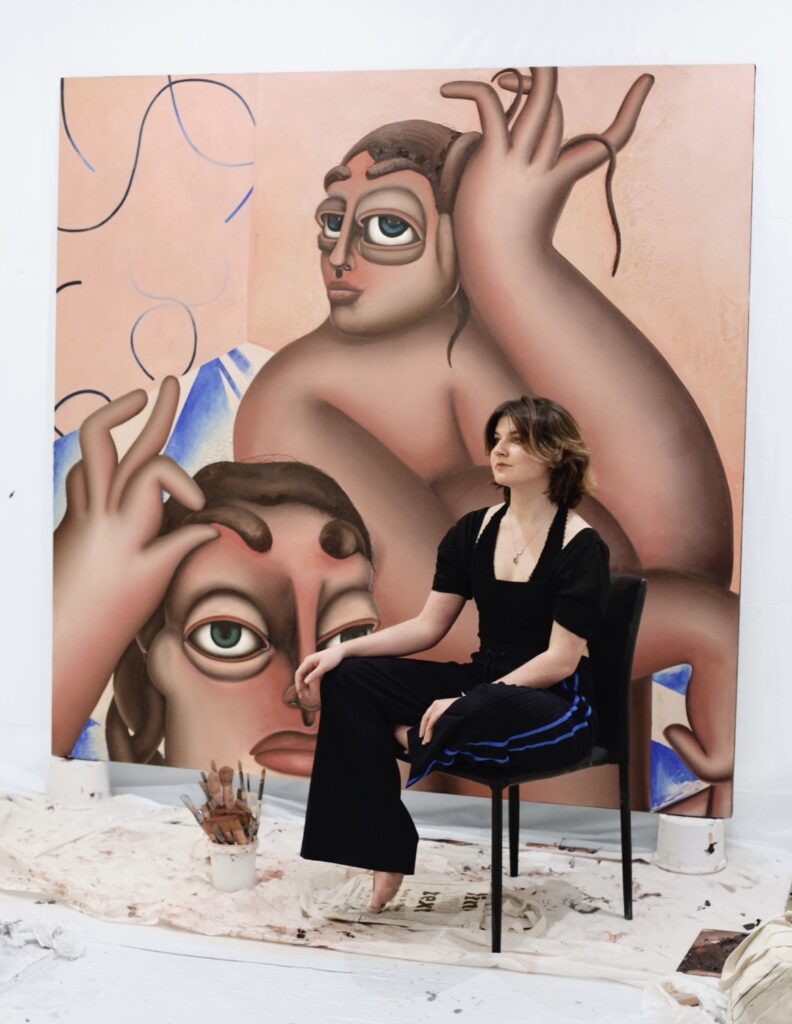
Georgia Dymock Photo Courtesy of: the Artist
DP- Can you tell us a little bit about your early childhood? When did you discover painting?
GD- I was a creative child, growing up in the countryside with no internet till I was 13, which meant that I had to be inventive and playful with the ways I spent my time. When we were young, my brother and I would create imaginative worlds, building dens in the woods close to our home. My mum is a sculptor, and I remember making coil pots and figurines with her as a young child. My interest in painting, especially expressing a human form through paint, came about after seeing the work of Otto Dix and Lucien Freud in a London gallery on a family trip to the city. I enjoyed the feeling of how the faces were sculpted with the medium of paint; I remember enjoying not only how the different tonalities built up the illusion of form but also how the paint was applied in thick slabs to the flat surface, as in the case of Lucian Freud. Returning home after the trip, I remember my first time experimenting with acrylic paint on paper.
DP- You want to imagine the body in the post-digital world. With society’s inherent pressure on body shapes and forms, will accepting one’s uniqueness be easier as time passes or harder?
GD-It feels as though body ideals are extremely apparent in today’s digital culture, where in post-digital society, everyone has access to a smartphone with a digital camera with which communicating with others visually has become common practice. I don’t have TikTok myself, but I remember feeling fascinated when my friend showed me the augmentation filters installed on the app that can recognize and change a face to adhere to idealized beauty- enlarge eyes, smooth out skin, enlarge lips, straighten, and reduce nose size. Technology is there nowadays to reimagine how we can look and present ourselves online. In ways, these tools are fun and playful, but I think it is important to be aware that this technology isn’t neutral and carries bias.
DP- You mentioned in an interview, “When you say, “I want to be an artist,” it feels risky. At school, if you were good at science or math or English, that is encouraged, but if you are good at art, it’s almost the opposite.” Before your first show at JD Malat Gallery, who or what encouraged you to pursue your art career?
GD- At school, I was really into sciences and thought I would end up having a career related to this. It was only during my anthropology degree I began to try painting and drawing in my free time. Moving and living in London for the first time, I suddenly found so many art and creative possibilities at my fingertips. Being able to visit museums and gallery shows, I felt excited and inspired by what I saw. After my anthropology degree, I enrolled in the Chelsea College of Arts Grad Diploma program; only after starting this, I felt that having a career in the arts might be possible.
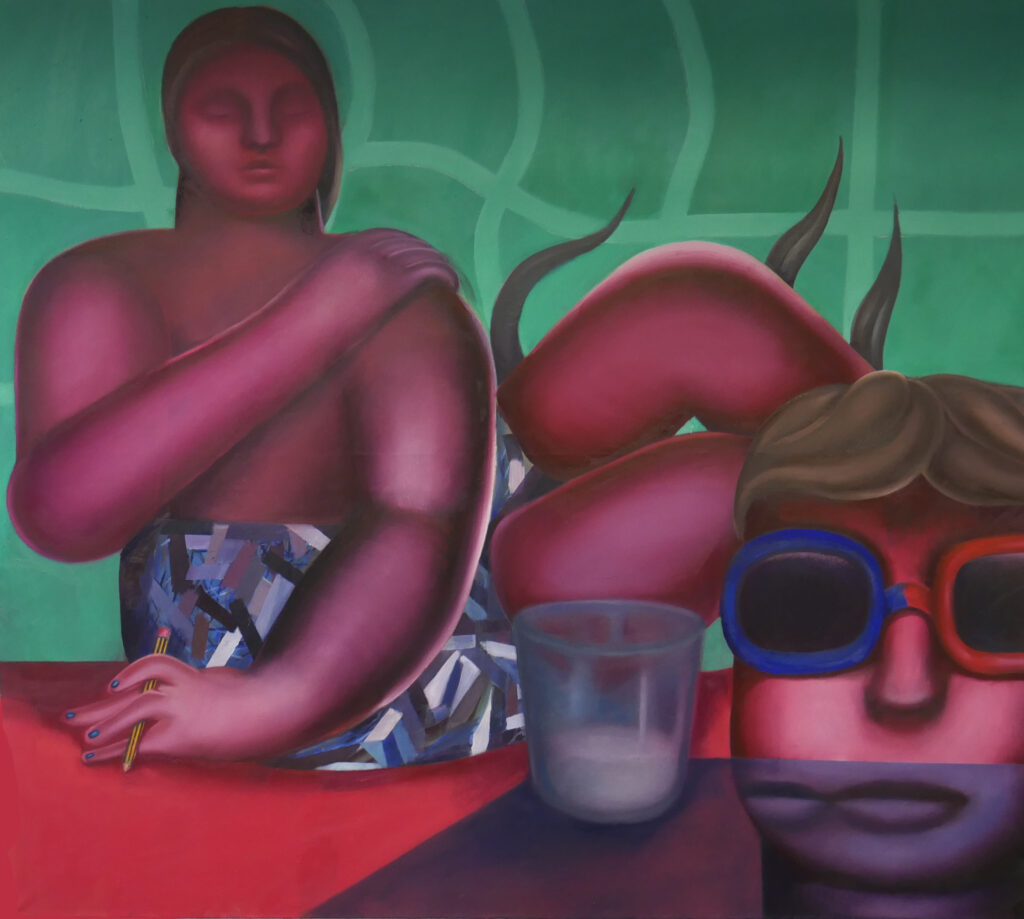
“Back to School”2022 Photo Courtesy of : JD Malat Gallery
DP- How can you influence the new generation of artists to feel empowered and encouraged?
Although this is an obvious answer, I say – don’t give up. Try to overcome any fear of failure or looking stupid in front of others; if anything, failure is a key part of the creative process and integral to learning and becoming a better artist. I would also say don’t be afraid to feel uncomfortable in your creative pursuits because I think these moments are when the most exciting and radical things can happen.
DP- Nowadays, we live in an image-driven culture, and you see a surface and get excited about it. But what really is that surface? What is that painting?
GD- I enjoy the materiality of oil paint and its versatile nature, where this can be highly rendered, built up in thick impasto strokes, or applied in light washes- Just a few ways in which this medium can be used. The materiality that is deeply inherent in painterly language gives painting a presence that feels distinctive in the digitalized era in which we live, where we are inundated with flat images contained within the small, slippery screens of our smartphones.
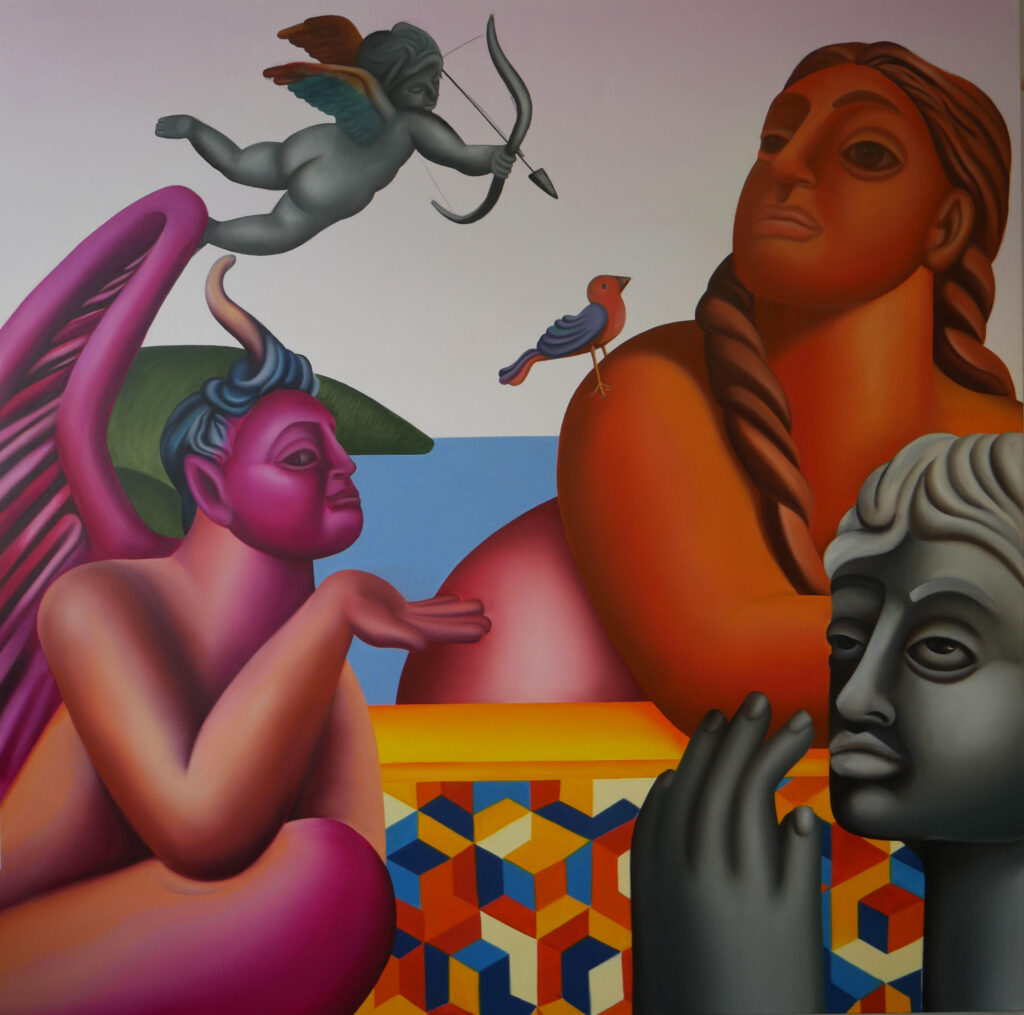
Photo courtesy of: JD Malat Gallery
After speaking with Georgia, a more profound, perhaps inspiring reflection could reveal that our experiences come down to this in our lifetime. Like the fly on the Sistine Chapel, we only see what is constructed from a tone of public sympathy, nearly robotic, with chunks of time spent utterly devoid of any course. We only realize the value of a moment once it becomes a memory. We cannot retrieve it, but we can imagine and dream; in that place, we can travel and assemble a realm uniquely our own. This sovereignty of thought occurs when we sleep and is repeatedly forgotten in our waking hours. But given enough air to breathe, we recall we can journey between worlds. It enables us to traverse space, time, and reality. Dreaming up a world created with our own vision, permitting us to unlock a magnificence of what could be formed within our thoughts from the comfort of peaceful certitude beneath our skin.
